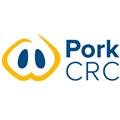 Pork CRC Program 4, ‘Carbon conscious nutrient inputs and outputs’, conducts research to improve the sustainability of the pork industry, specifically to reduce greenhouse gas emissions to about 1 kg carbon dioxide (CO2) equivalent/kg pork produced.
Pork CRC Program 4, ‘Carbon conscious nutrient inputs and outputs’, conducts research to improve the sustainability of the pork industry, specifically to reduce greenhouse gas emissions to about 1 kg carbon dioxide (CO2) equivalent/kg pork produced.
An outcome of the program has been the increasing adoption of covered anaerobic lagoons by Australian pork producers to manage greenhouse gas (GHG) emissions and recover the methane from biogas for energy production. The biogas also contains CO2.

Algal biomass produced in high rate algal ponds (HRAP) treating piggery wastewater can remove CO2, from the slurry and potentially from the biogas, contributing to GHG mitigation. The biomass is also an additional source of energy, which could be released via anaerobic digestion or co-digestion with pig slurry.
While other wastes, such as industrial organic wastes, fruit, vegetables and olive wastes, are commonly co-digested, there have been limited studies on the digestion of algal biomass as a sole substrate or co-digested with other wastes such as pig slurry.
Flinders University research higher degree student Ryan Cheng’s Pork CRC supported PhD thesis, ‘Exploitation of wastewater grown microalgae for the production of biogas,” investigated the effect of CO2 addition on algal growth and methane production from the digestion of algae and their co-digestion with other liquid wastes, including pig slurry.
Dr Cheng, who has a Bachelor of Medical Science with majors in microbiology, neuroscience and physiology and a Bachelor of Science (Hons), both from South Australia’s Flinders University, was recently awarded his doctorate.
According to his PhD Supervisor, Prof Howard Fallowfield, his results question if adding CO2 enhances algal production in all types of wastewater.
In Dr Cheng’s PhD research, a laboratory approach was used to examine the effect of the addition of CO2 on the growth of microalgae in wastewaters of three different strengths determined by their biochemical oxygen demand (BOD).
“Results demonstrated that adding CO2 did not increase biomass production in wastewaters rich in organic carbon, since the CO2 produced by bacterial mineralisation, adequately supported optimal biomass production,” Dr Cheng said.
Co-digestion of pig slurry with algal biomass resulted in a slightly higher methane yield.
“My research ultimately provided a better understanding of how to achieve integration of algae and wastewater treatment by determining if it is necessary to supply external CO2 and evaluating the outcome of anaerobic co-digestion of algal biomass with pig slurry or waste activated sludge,” Dr Cheng said.
June 14, 2017 - Pork CRC



